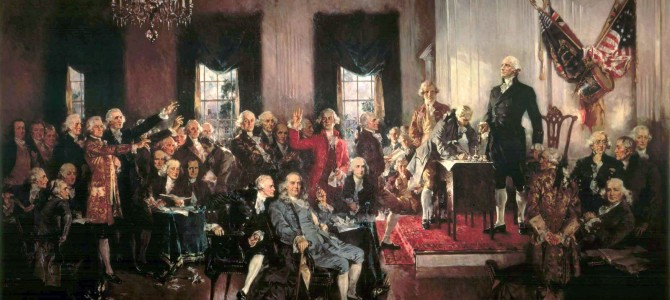
Let’s face it: sometimes history seems irrelevant. We’re living in a modern technological wonderland of smart phones, Direct TV on airplanes, and online shopping. Yet what makes history both relevant and intriguing is the humanity behind it: the universal qualities and daily life applications that we can discover in the past.
So it is with the behind-the-scenes story of drafting the U.S. Constitution in 1787, which we mark every year on September 17 as Constitution Day. If we look back, we find that James Madison’s problem-solving skills are as applicable and useful today as they were back then.
1. Define the Problem
After the Revolutionary War, the United States operated under the Articles of Confederation. But U.S. leaders soon realized these lacked the power to create something as essential as a common U.S. currency and regulate trade between states (among many other problems).
What to do? American statesman and future president James Madison, who lived at Montpelier (now a must-see museum in Virginia), decided to problem-solve by researching some options.
2. Research Your Options
First, Madison read numerous books on government—including 13 volumes of political history and 11 volumes on the history of humanity. In this way, he “Googled” his way through the topic of government.
3. Figure Out What Works
Madison then considered what had and hadn’t worked in other countries and civilizations. Just as modern business leaders do today, he analyzed best and worst practices and applied them to the context and principles of American independence.
Realizing that the Articles were too weak to merely be tweaked, Madison envisioned a new Constitution based on three branches of government: “I have sought for some middle ground . . . I would propose as the groundwork that a change be made in the principle of representation,” he concluded.
4. Find a Reliable Backer
But in order to propose this new Constitution, Madison knew he needed a reliable backer. So he sought the help of an influential person: General George Washington, who had commanded the Continental Army in the spring of 1787.
“Having . . . formed in my mind some outlines of a new system, I take the liberty of submitting them without apology to your eye,” Madison wrote to Washington.
Madison encouraged Washington to attend the upcoming convention of leaders meeting in Philadelphia to discuss the problems with the Articles. Agreeing, Washington presided over the convention, which included dozens of men from the 13 states.
5. Keep a Cheat Sheet of Facts and Data
Just as politicians and communicators today create talking points or bulleted lists, so Madison created a 40-page, pocket-sized booklet of facts to carry with him during informal and formal debates. He had at his disposal historical evidence to refute arguments made by convention members who might oppose his plan.
6. Go Out For Coffee Or Drinks
Although a reserved man with an introverted nature, Madison used his skills of persuasion both on the convention floor and in small groups. Convention attendees shared coffee and ale at taverns in Philadelphia. Unlike some, Madison knew how to disagree without being disagreeable. His quiet, reasoned, logical, and well-researched answers often overcame the loud and inflammatory rhetoric of more impassioned tempers.
7. Be a Team Player
Because he’d so thoroughly studied ancient governments and dissected their defects, Madison emerged as one of the most effective and important members of the Constitutional Convention.
To be clear, Madison didn’t get everything he wanted—but that wasn’t the point or his goal. His purpose was to compromise by creating a stronger national government that was not too strong. The resulting document was not perfect—but it was a start. The U.S. Constitution was approved by the convention on September 17, 1787.
8. Market and Communicate
Traveling to New York, Madison mapped a public relations effort with many others to motivate at least nine of the 13 states to ratify the Constitution through special state conventions. His 29 essays, along with those by Alexander Hamilton and John Jay, became known as “The Federalist Papers,” with a total of 85 essays.
During this campaign, he also worked with Rufus King, a New Yorker who later became one of Madison’s strongest opponents and fiercest rivals during his presidency. This fostered much of the political drama and intrigue I write about in my new nonfiction book, “The Burning of the White House: James and Dolley Madison and the War of 1812.”
“The Federalist Papers” influenced many and became a foundational work of American political thought and theory. The campaign worked. The states adopted the U.S. Constitution.
9. Give Credit to Others
Although Madison was a central figure in the greatest accomplishment of his century, he was careful not to make it all about him. Many people called him the Father of the Constitution, a title he rejected.
“You give me a credit to which I have no claim in calling me ‘The writer of the Constitution of the U.S.’ This was not like the fabled Goddess of Wisdom, the offspring of a single brain. It ought to be regarded as the work of many heads and many hands,” he wrote.
Just as we keep photos and mementos of special times in our lives, so Madison was sentimental about the problem-solving summer of 1787.
“Of all the situations Mr. Madison ever occupied, there was no one he was as fond of talking about as the convention of 1787, which made the Constitution,” wrote Edward Coles, Madison’s secretary.
While few people will produce anything as foundational as the U.S. Constitution, Madison’s relatable, applicable problem-solving skills are inspirational and relatable for our lives today.









